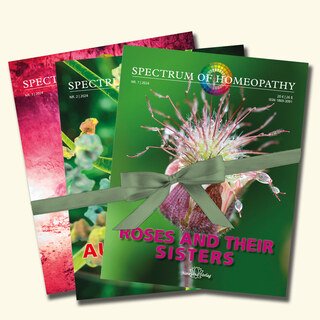“Spectrum of Homeopathy” is Narayana Publishers’ new journal, whose aim is to combine thorough clinical experience, compact information of materia medica, and diversity of methods.
Issues of 2024:
1/2024 Roses
“A rose is a rose is a rose.” This phrase from Gertrude Stein’s poem “Sacred Emily” is often quoted when something is entirely clear. In this edition of SPECTRUM you will see that things are not necessarily so clear cut for Rosidae, Rosales and Rosaceae. In the highly branched clan of “Roses and Their Sisters” we can find the proud and beautiful hybrid tea roses as well as their wild and unkempt but often very useful siblings. The substantial differences in the members of this large family are reflected in our ambivalent attitude to the rose. The intoxicating scent and the magic that they exude has made them a symbol of sensuality and romantic love. At the same time they represent transience, pain and violation.
In contributions to this issue we find many varieties of love: there is the self-love of the proud and beautiful Rosa damascena, the idealising and suffocating love of Agrimonia eupatoria, the love of work characteristic of Hippophae rhamnoides or the spiritual love of Ficus carica. The fig tree belongs just as much to the Rosidae as do the sea buckthorn tree and common agrimony. According to the Conquist classification used by Michal Yakir and Rajan Sankaran, the Rosidae are subclass 5 in the dicotyledonous flowering plants. These two pioneers of homeopathy present their own contributions on this subclass, based on human individuation (Yakir) and the sensation method (Sankaran). Their insights and those of Jan Scholten’s plant theory play a major role in the case analyses in this issue. The authors present numerous instructive examples for the practical application of the differing homeopathic plant systems.
The diversity and contradictions in the rose garden are reflected in the case histories of our international authors on the Rosales and various remedies from the related orders of the Rosidae. This issue of SPECTRUM clarifies the group picture of the rose clans, helping us to recognise the subclass, order and family of the roses in practice so that Laurie Dack convincingly titles her piece on the touching story of the collapsing baby: “A Rose is a rose is a rose.” In this case Laurocerasus is the simillimum for both mother and child. It runs in the family.
2/2024 Autoimmunity
Immune reactions towards a person’s own body are often associated with severe pathology and ongoing destruction of the affected tissue. The standard treatment with immune suppressants aims to impede this chronic process but can in turn permanently damage the body. For many of those affected, homeopathy offers a possible solution to this dilemma. This issue of SPECTRUM examines questions such as what needs to be considered when treating autoimmune disease with homeopathy and how to coordinate this with conventional treatment, which methodological approaches are relevant and also which remedy groups are particularly well-suited as well as how to assess the reaction. The healing processes seen in the numerous cases presented – including vitiligo, rheumatoid arthritis, ankylosing spondylitis and chronic inflammatory bowel disease – demonstrate the potential of homeopathic treatment for autoimmune problems. Our renowned international authors from a range of homeopathic schools present their approach to this clinical problem with its severe pathology.
3/2024 Gases
Remedy families play an ever-greater role in homeopathic case analysis. They usually correspond to the classifications into the various natural kingdoms familiar from biology and physics. Yet some groups are based on specific common characteristics. Drug remedies are characterised by a similar effect on people, sea remedies share the same habitat, and so on. Gases are defined by their aggregate state at 0o celsius. Lacking a firm shape or structure, they can be compressed or they can expand to fill the entire available space. Their special properties are expressed in homeopathic casetaking at the sensation level as a feeling of constriction, compulsion and pressure – or as the opposite, boundless expansion. With a gaseous remedy the typical sensations are related to the position in the periodic table. Gases are found above all in the second row of the periodic table (oxygen, ozone, nitrogen) and in stages seven (halogens) and eight (noble gases). Along with these gaseous elements, this issue also presents compounds such as Phosphorus hydrogenisatus or Ammonium causticum and the path to the selection of such little-known remedies is described along with casetaking.
 Wunschliste
Wunschliste





